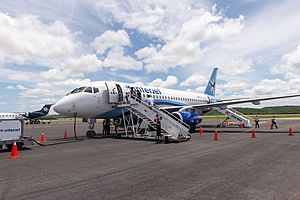Sukhoi facts for kids
Sukhoi is a big company in Russia. It makes many different kinds of aircraft. More than 29,000 people work for Sukhoi.
The company handles everything about planes. This includes designing them and making them. They also help keep the planes working after they are sold.
Sukhoi is famous for its "Su-" series of combat aircraft. These planes are very advanced. They are used by Russia's air force. Many other countries also use Sukhoi planes.
Sukhoi is one of the top companies in the world. It is a major maker of planes sold to other countries. They are third in the world for making modern fighter jets.
Sukhoi has created some very innovative planes. One example is the Su-37 Super Flanker.
The United States bought some aircraft from Sukhoi for training. However, when Sukhoi sold aircraft to Iran, the United States stopped doing business with them.
Contents
History of Sukhoi Aircraft
The story of Sukhoi began in October 1930. A team led by P.O. Sukhoi started designing planes. This was the beginning of the Sukhoi Design Bureau.
Early Aircraft Designs
Over the next nine years, the team created several planes. They made experimental fighter planes like the I-3 and I-14.
They also built the RD aircraft. This plane set a world record for long-distance flight. It flew 10,148 kilometers in over 62 hours.
Another plane was the DB-2 bomber. An improved version, called Rodina, flew non-stop from Moscow to the Far East. This flight was made by an all-female crew.
The multi-role BB-1 aircraft was also made. Later, it was called the Su-2. This was the first Sukhoi plane made in large numbers. About 910 of these planes were built.
The Su-2 was used as a bomber and for scouting. It played an active part in the Great Patriotic War.
Sukhoi Becomes a Standalone Company
In 1939, P.O. Sukhoi became the Chief Designer. His team became a standalone Design Bureau. They moved to a production plant in Kharkov.
After this, the team worked on new versions of the Su-2. They also developed the Su-6 attack aircraft. P.O. Sukhoi won a special prize for this plane in 1943.
Other planes from this time include the Su-1 fighter. They also made the Su-8 attack aircraft. Experimental planes like the Su-5 and Su-7 were also developed. These had special combined engines.
Post-War Jet Aircraft
After 1945, Sukhoi started making jet fighters. These included the Su-9, Su-11, Su-15, and Su-17. They also developed the Su-10 jet bomber.
The twin-engine Su-12 was a piston-powered scouting plane. They also worked on passenger planes.
In the five years after the war, Sukhoi developed new aviation technologies. They created the first booster aircraft control system. They also made the first landing braking parachute.
They also invented the first catapult ejection seat. This helped pilots escape from planes in an emergency.
Supersonic Jet Era
In 1949, the Design Bureau was temporarily closed. But in May 1953, it reopened with new facilities. This was when supersonic jet planes became important.
Sukhoi's main projects were the supersonic fighters S-1 and T-3. The S-1 led to the Su-7 and Su-17 fighter-bombers. The Su-17 was the first Soviet plane with a variable sweep wing. This means its wings could change shape during flight.
The T-3 led to the Su-9-51 missile system. Later, the Su-11-8M and Su-15-98(M) systems were also developed.
In the 1960s, Sukhoi developed more aircraft. In 1962, they started building the T-4. This was a long-range attack and scouting plane. Its first flight was in 1972.
The T-4 was special because it had the country's first fly-by-wire system. This means computers helped control the plane. It also had an automatic throttle control.
Modern Combat Aircraft
In 1969, the Su-24 bomber made its first flight. This was the first Soviet all-weather attack plane. It could fly in any weather. The Su-24 is still used today by Russia and other countries.
In 1975, the Su-25 attack aircraft flew for the first time. This plane was designed to destroy targets on the battlefield. It was the first mass-produced jet attack aircraft in the nation. The Su-25 is a very important plane for Russia's air force.
In 1969, Sukhoi began working on a fourth-generation fighter. In 1977, the Su-27 fighter made its first flight. This plane led to many other versions. These include the Su-27UB, Su-30, Su-32, and Su-33.
Sukhoi also developed the Su-47 in 1997. This experimental plane helped test new designs and materials.
Aerobatic and Civil Aircraft
Sukhoi used its experience to create aerobatic planes. These are planes made for amazing flying stunts. The Su-26, Su-29, and Su-31 are examples.
Pilots using these planes have won many medals. They have won 330 medals, including 156 gold medals, at world championships.
In the early 1990s, Sukhoi started working on planes for everyday use. In 2001, the Su-80GP transport plane flew. The Su-38L agricultural plane also had its first flight.
Today, Sukhoi Civil Aircraft is developing a family of regional planes called RRJ.
Over the years, Sukhoi has developed about 100 types of aircraft. More than 60 types have been produced. In total, over 10,000 planes have been built. More than 2,000 of these planes have been sold to 30 different countries. Sukhoi planes have also set over 50 world records.
Images for kids
-
A stamp of Pavel Sukhoi, the founder of the Sukhoi Design Bureau
See also
 In Spanish: Sukhoi para niños
In Spanish: Sukhoi para niños



